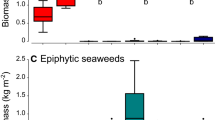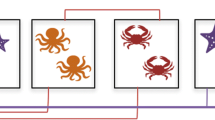Abstract
The number of common eiders (Somateria mollissima borealis) in west Greenland declined dramatically during the twentieth century, supposedly because of human activities. However, their sensitivity to alternative drivers of variation, such as climate conditions, diseases or food availability, remains unstudied. In this study, we describe prey availability and assess the trophic coupling between eiders and their macrobenthic prey in a shallow inlet, Nipisat Sound; a key wintering habitat in the south-west Greenland Open Water Area. Macrobenthic species abundance and biomass were studied, and annual production was estimated by an empirical model, including environmental characteristics, fauna composition and individual biomass. In spring 2008, average macrozoobenthic abundance and biomass were 6,912 ind m−2 and 28.4 g ash-free dry mass (AFDM) m−2 (647 kJ m−2), respectively. Annual production was estimated at 13.9 g AFDM m−2 year−1 (317 kJ m−2 year−1). During the winters of 2008–2010, we monitored the number of common eiders (S. mollissima borealis) and king eiders (Somateria spectabilis) and observed a distinct peak in abundance during winter with up to 15.000 birds in Nipisat Sound. Based on physiological costs of different activities in combination with the observed behavioural pattern, we obtained an estimate of the energy required for eiders to balance their costs of living, which amounted to 58% of the estimated total annual production of macrobenthos in Nipisat Sound. This result suggests that eider predation affects macrobenthic species composition and biomass and demonstrates the potential importance of variations in prey availability for the population dynamics of eiders in Greenland.




Similar content being viewed by others
References
Blicher ME, Rysgaard S, Sejr MK (2007) Growth and production of sea urchin Strongylocentrotus droebachiensis in a high-Arctic fjord, and growth along a climatic gradient (64–77°N). Mar Ecol Prog Ser 341:89–102
Blicher ME, Sejr MK, Rysgaard S (2009) High carbon demand of dominant macrozoobenthic species indicates their central role in ecosystem carbon flow in a sub-Arctic fjord. Mar Ecol Prog Ser 383:127–140
Blicher ME, Rysgaard S, Sejr MK (2010) Seasonal growth variation of Chlamys islandica (Bivalvia) in sub-Arctic Greenland is linked to food availability and temperature. Mar Ecol Prog Ser 407:71–86
Boertmann D, Lyngs P, Merkel FR, Mosbech A (2004) The significance of Southwest Greenland as winter quarters for seabirds. Bird Conserv Int 14:87–112
Brey T (1999) A collection of empirical relations for use in ecological modelling. NAGA ICLARM Q 22(3):24–28
Brey T (2001) Population dynamics in benthic invertebrates. A virtual handbook. Version 01.2. http://www.thomas-brey.de/science/virtualhandbook
Bustnes JO, Lønne OJ (1997) Habitat partitioning among sympatric wintering common eiders Somateria molissima and king eiders Somateria spectabilis. Ibis 139:549–554
Cappelen J, Jørgensen B, Laursen E, Stannius L, Thomsen R (2001) The observed climate of Greenland, 1958-99—with climatological standard normals, 1961–90. Danish Meterological Institute, Ministry of transport, Copenhagen
Durinck J, Skov H, Jensen FP, Pihl S (1994) Important marine areas for wintering birds in the Baltic Sea. Ornis consult report to the european commission, 110 pp
Ellis H, Gabrielsen G (2001) Energetics of free-ranging seabirds. In: Schreiber EA, Burger J (eds) Biology of marine birds. CRC Press, Boca Raton, pp 359–408
Frimer O (1997) Diet of moulting king eiders Somateria spectabilis at Disko Island, West Greenland. Ornis Fennica 74:187–194
Gilliland SG, Gilchrist HG, Rockwell RF, Robertson GJ, Savard J-PL, Merkel F, Mosbech A (2009) Evaluating the sustainability of harvest among northern common eiders Somateria mollissima borealis in Greenland and Canada. Wildlife Biol 15:24–36
Glud RN, Berg P, Hume A, Batty P, Blicher ME, Lennert K, Rysgaard S (2010) Benthic O2 exchange rates across hard bottom substrates quantified by eddy correlation in a sub-Arctic fjord system. Mar Ecol Prog Ser 417:1–12
Goudie RI, Robertson GJ, Reed A (2000) Common eider (Somateria mollissima). In: Poole A, Gill F (eds) The birds of North America, no. 546. The Academy of Natural Sciences, Philadelphia, PA, and The American Ornithologists’ Union, Washington DC, p 32
Gray JS (2002) Species richness of marine soft sediments. Mar Ecol Prog Ser 244:285–297
Grebmeier J, Feder H, McRoy C (1989) Pelagic-benthic coupling on the shelf of the northern Bering and Chuchi Seas. II. Benthic community structure. Mar Ecol Prog Ser 51:253–268
Grebmeier JM, Cooper LW, Feder HM, Sirenko BI (2006) Ecosystem dynamics of the Pacific-influenced Northern Bering and Chukchi Seas in the Amerasian Arctic. Prog Oceanogr 71:331–361
Guillemette M, Ydenberg RC, Himmelman JH (1992) The role of energy intake rate in prey and habitat selection of common eiders Somateria mollissima in winter—a risk-sensitive interpretation. J Anim Ecol 61:599–610
Guillemette M, Reed A, Himmelman JH (1995) Availability and consumption of food by common eiders wintering in the Gulf of St. Lawrence: evidence for prey depletion. Can J Zool 74:32–38
Hamilton DJ (2000) Direct and indirect effects of predation by common eiders and abiotic disturbance in an intertidal community. Ecol Monogr 70:21–43
Hawkins PAJ, Butler PJ, Woakes AJ, Speakman JR (2000) Estimation of the rate of oxygen consumption of the common eider duck (Somateria mollissima), with some measurements of heart rate during voluntary dives. J Exp Biol 203:2819–2832
Jamieson SE (2003) Endogenous reserve dynamics of Northern common eiders (Somateria mollissima borealis) wintering in Greenland. Master thesis, University of New Brunswick, Canada
Jamieson SE, Gilchrist HG, Merkel FR, Diamond AW, Falk K (2006) Endogenous reserve dynamics of northern common eiders wintering in Greenland. Pol Biol 29:585–594
Jenssen B, Ekker M, Bech C (1989) Thermoregulation in winter-acclimatized common eiders (Somateria mollissima) in air and water. Can J Zool 67:669–673
Juul-Pedersen T, Rysgaard S, Batty P, Mortensen J, Retzel A, Nygaard R, Burmeister A, Mikkelsen D, Sejr MK, Blicher ME, Krause-Jensen D, Christensen PB, Labansen AL, Rasmussen LM, Simon M, Boye TK, Madsen PT, Ugarte F (2009) Nuuk basic: the marinebasic programme 2008. In: Jensen LM, Rasch M (eds) Nuuk ecological research operations, 2nd annual report, 2008. National Environmental Research Institute, Aarhus University, Denmark, pp 39–58
Larsen JK, Guillemette M (2000) Influence of annual variation in food supply on abundance of wintering common eiders Somateria mollissima. Mar Ecol Prog Ser 201:301–309
Lovvorn JR, Grebmeier JM, Cooper LW, Bump JK, Richman SE (2009) Modeling marine protected areas for threatened eiders in a climatically changing Bering Sea. Ecol Monogr 19(6):1596–1613
Meire PM, Schekkerman H, Meininger PL (1994) Consumption of benthic invertebrates by waterbirds in the Oosterschelde estuary, SW Netherlands. Hydrobiologia 282/283:525–546
Merkel FR (2004a) Evidence of population decline in common eiders breeding in western Greenland. Arctic 57:27–36
Merkel FR (2004b) Impact of hunting and gillnet fishery on wintering eiders in Nuuk, Southwest Greenland. Waterbirds 27:469–479
Merkel FR, Mosbech A (2008) Diurnal and nocturnal feeding strategies in common eiders. Waterbirds 31:580–586
Merkel FR, Mosbech A, Boertmann D, Grøndahl L (2002) Winter sea-bird distribution and abundance off south-western Greenland, 1999. Polar Res 21:17–36
Merkel FR, Mosbech A, Sonne C, Flagstad A, Falk K, Jamieson SE (2006) Local movements, home ranges and body condition of common eiders, Somateria mollissima, wintering in Southwest Greenland. Ardea 94:639–650
Merkel FR, Jamieson SE, Falk K, Mosbech A (2007a) The diet of common eiders wintering in Nuuk, Southwest Greenland. Pol Biol 30:227–234
Merkel F, Mosbech A, Jamieson S, Falk K (2007b) The diet of king eiders wintering in Nuuk, Southwest Greenland, with reference to sympatric wintering common eiders. Pol Biol 30:1593–1597
Merkel FR, Mosbech A, Riget F (2009) Common Eider Somateria mollisima feeding activity and the influence of human disturbances. Ardea 97:99–107
Mikkelsen D, Rysgaard S, Glud R (2008a) Microalgal composition and primary production in Arctic sea ice: a seasonal study from Kobbefjord (Kangerlauarsunnguaq), West Greenland. Mar Ecol Prog Ser 368:65–74
Mikkelsen DM, Rysgaard S, Mortensen J, Retzel A et al (2008b) Nuuk basic: the marinebasic programme 2007. In: Jensen LM, Rasch M (eds) Nuuk ecological research operations, 1st annual report, 2007. Danish Polar Centre, Danish Agency for Science, Technology and Innovation, Ministry of Science, Technology and Innovation, Copenhagen, pp 54–73
Mosbech A, Gilchrist HG, Merkel FR, Sonne C, Flagstad A, Nyegaard H (2006a) Year-round movements of northern common eiders Somateria mollissima borealis breeding in Arctic Canada and West Greenland followed by satellite telemetry. Ardea 94:651–665
Mosbech A, Danø R, Merkel F, Sonne C, Gilchrist HG, Flagstad A (2006b) Use of telemetry to locate key habitats for king eiders Somateria spectabilis in West Greenland. In: Boere GC, Galbraith CA, Strout DA (eds) Waterbirds around the world. The Stationary Office, Edinburgh, pp 769–776
Müller R (1906) Vildtet og jagten i Sydgrønland. Hovedkomm. for Norge: H. Aschehoug, Oslo
Nehls G (1989) Occurrence and food consumption of the common eider, Somateria mollissima, in the Wadden Sea of Schleswig-Holstein. Helgol Meeresunters 43:385–393
Nilsen M, Pedersen T, Nilssen EM (2006) Macrobenthic biomass, productivity (P/B) and production in a high-latitude ecosystem, North Norway. Mar Ecol Prog Ser 321:67–77
Oppel S, Powell AN (2009) Does winter region affect spring arrival time and body mass of king eiders in northern Alaska? Pol Biol 32:1203–1209
Pelletier D, Guillemette M, Grandbois J-M, Butler PJ (2008) To fly or not to fly: high flight costs in a large sea duck do not imply an expensive lifestyle. Proc R Soc B 275:2117–2124
Petersen IK, Fox AD, Clausager I (2003) Distribution and numbers of birds in Kattegat in relation to the proposed offshore wind farm south of Læsø—ornithological impact assessment. Department of Wildlife Ecology and Biodiversity. National Environmental Research Institute, Ministry of Environment, Denmark
Richman S, Lovvorn J (2003) Effects of clam species dominance on nutrient and energy acquisition by spectacled eiders in the Bering Sea. Mar Ecol Prog Ser 261:283–297
Richman SE, Lovvorn JR (2009) Predator size, prey size and threshold food densities of diving ducks: does a common prey base support fewer large animals? J Anim Ecol 78:1033–1042
Rysgaard S, Arendt KE, Frederiksen MS, Egevang C et al (2008) Nuuk basic: The marinebasic programme 2005–2006. In: Jensen LM, Rasch M (eds) Nuuk ecological research operations, 1st annual report, 2007. Danish Polar Centre, Danish Agency for Science, Technology and Innovation, Ministry of Science, Technology and Innovation, Copenhagen, pp 38–53
Scheiffarth G, Nehls G (1997) Consumption of benthic fauna by carnivorous birds in the Wadden Sea. Helgol Meeresunters 51:373–387
Schmid MK, Piepenburg D (1993) The benthos zonation of the Disko fjord, West Greenland. Meddelelser om Grønland, Bioscience 37:3–21
Sejr MK, Christensen PB (2007) Growth, production and carbon demand of macrofauna in Young Sound, with special emphasis on the bivalves Hiatella arctica and Mya truncata. In: Rysgaard S, Glud RN (eds) Carbon cycling in Arctic marine ecosystems: case study young sound, vol 58, Bioscience. Meddelelser om Grønland, Copenhagen, pp 122–135
Sejr MK, Włodarska-Kowalczuk M, Legeżyńska J, Blicher M (2010) Macrobenthic species composition and diversity in the Godthaabsfjord system, SW Greenland. Pol Biol 33:421–431
Smidt E (1979) Annual cycles of primary production and of zooplankton at southwest Greenland, vol 1. Greenland Bioscience, pp 1–53
Zwarts L, Wanink JH (1993) How the food supply harvestable by waders in the Wadden Sea depends on the variation in energy density, body weight, biomass, burying depth and behaviour of tidal-flat invertebrates. Neth J Sea Res 31:441–476
Acknowledgments
Thanks to A. Haxen for linguistic corrections. We thank L. Heilmann and F. Heinrich for technical assistance. The authors were financially supported by The Commission for Scientific Research in Greenland (KVUG), The Ministry of Culture, Education and Churches (KIIP) and the Aage V. Jensen Charity Foundation. The project has received financial support from the Danish Energy Agency as part of the climate support programme to the Arctic and is a contribution to the Greenland Ecosystem Monitoring Program. The study was supported by the Danish Agency for Science, technology and Innovation and was a part of the Greenland Climate Research Centre.
Author information
Authors and Affiliations
Corresponding author
Rights and permissions
About this article
Cite this article
Blicher, M.E., Rasmussen, L.M., Sejr, M.K. et al. Abundance and energy requirements of eiders (Somateria spp.) suggest high predation pressure on macrobenthic fauna in a key wintering habitat in SW Greenland. Polar Biol 34, 1105–1116 (2011). https://doi.org/10.1007/s00300-011-0968-3
Received:
Revised:
Accepted:
Published:
Issue Date:
DOI: https://doi.org/10.1007/s00300-011-0968-3




